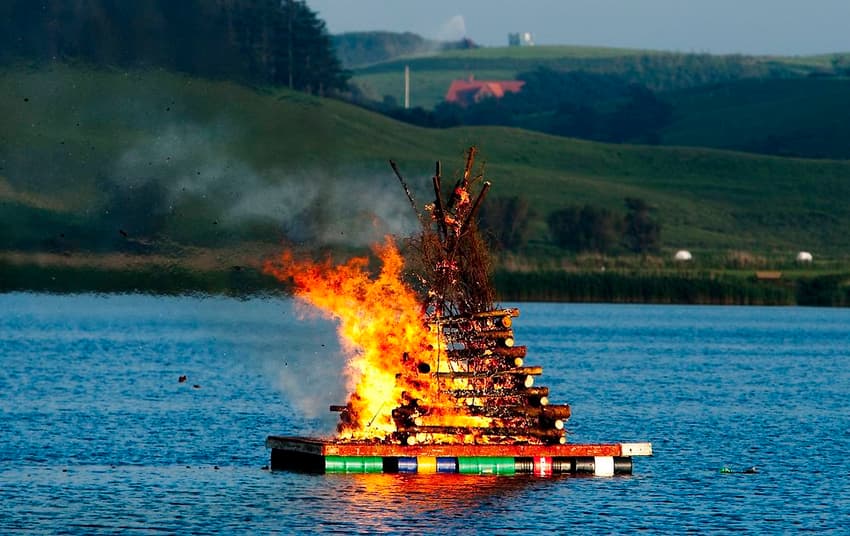holiday
For Members
Witches and rain: Denmark's Sankt Hans Aften explained

Bonfires will be lit to the sound of singing in chorus across Denmark on Wednesday night as traditional Sankt Hans Aften celebrations take place.
Although many cultures celebrate Midsummer – the shortest night of the year – with fire, in Denmark the night is infused with customs that harken back to darker and more superstitious times in the country’s history.
Sankt Hans Aften (St. John’s Eve) takes its name from John the Baptist, who according to Christian tradition was born six months before Jesus. With Christmas celebrated on December 24th in Denmark, that puts John’s birthday on June 24th. The tradition of celebrating the eve of his birthday with a bonfire dates back to the 1600s.
Although the holiday is nominally Christian, it is built upon pagan traditions. According to legend, the summer solstice is a night imbued with evil, a night in which witches make their way to the Brocken, the highest summit in the Herz mountains in northern Germany. In order to ward off those broomstick-riding witches and their evil troll accomplices, Danes light a bonfire to keep the spooky forces at bay.
And if that weren’t enough, the bonfires themselves are topped with a witch figure which is set ablaze on a night when Danes eat, drink and make merry in recognition of summer’s peak and the coming of longer nights.
While the witch-burning has survived the years, the old tradition of collecting and consuming magical herbs has mostly been replaced by getting together with family and friends for dinner and drinks.
While the witches being burned on Sankt Hans Aften are of the paper and hay variety, roughly 1,000 real men and women convicted of witchcraft were burned alive in Denmark in the 16th and 17th centuries. The last ‘witch’ to be killed in this way was Anne Palles, a Danish woman accused of sorcery and executed in 1693 on the island of Falster.
Sankt Hans Aften is traditionally seen as the peak of summer and associated with beautiful late sunsets, but Denmark's climate often sees to it ending up a very wet affair.
A previous version of this article was originally published on June 23rd, 2020.
Comments
See Also
Although many cultures celebrate Midsummer – the shortest night of the year – with fire, in Denmark the night is infused with customs that harken back to darker and more superstitious times in the country’s history.
Sankt Hans Aften (St. John’s Eve) takes its name from John the Baptist, who according to Christian tradition was born six months before Jesus. With Christmas celebrated on December 24th in Denmark, that puts John’s birthday on June 24th. The tradition of celebrating the eve of his birthday with a bonfire dates back to the 1600s.
Although the holiday is nominally Christian, it is built upon pagan traditions. According to legend, the summer solstice is a night imbued with evil, a night in which witches make their way to the Brocken, the highest summit in the Herz mountains in northern Germany. In order to ward off those broomstick-riding witches and their evil troll accomplices, Danes light a bonfire to keep the spooky forces at bay.
And if that weren’t enough, the bonfires themselves are topped with a witch figure which is set ablaze on a night when Danes eat, drink and make merry in recognition of summer’s peak and the coming of longer nights.
While the witch-burning has survived the years, the old tradition of collecting and consuming magical herbs has mostly been replaced by getting together with family and friends for dinner and drinks.
While the witches being burned on Sankt Hans Aften are of the paper and hay variety, roughly 1,000 real men and women convicted of witchcraft were burned alive in Denmark in the 16th and 17th centuries. The last ‘witch’ to be killed in this way was Anne Palles, a Danish woman accused of sorcery and executed in 1693 on the island of Falster.
Sankt Hans Aften is traditionally seen as the peak of summer and associated with beautiful late sunsets, but Denmark's climate often sees to it ending up a very wet affair.
A previous version of this article was originally published on June 23rd, 2020.
Join the conversation in our comments section below. Share your own views and experience and if you have a question or suggestion for our journalists then email us at [email protected].
Please keep comments civil, constructive and on topic – and make sure to read our terms of use before getting involved.
Please log in here to leave a comment.